For the Love of Ferns: Solutions for Our Garden’s Challenges

Eared lady fern, Athyrium otophorum, displays a variety of colors as the fronds mature. It retains its burgundy stipes.
The Fern Solution
Once upon a time, I considered ferns the magical solution to most of my gardening challenges. Deep dry shade? Plant some Polystichum, Christmas ferns. Soggy shade? Plant some cinnamon or ostrich ferns. A wet meadow in partial sun? Marsh ferns, Thelypteris, will thrive. Winter color in part sun? Plant some Dryopteris ‘Autumn Brilliance’ ferns. Deer? Bunnies? No worries, grazers normally ignore the ferns, and especially avoid the Cyrtomium holly fern species. Slopes with too much erosion? Plant some combination of Onoclea, sensitive ferns along with Deparia, Japanese sword ferns, because both spread beautifully. Then add a few Adiantums to the mix to create more texture. Every fern filters the air, removing carbon dioxide and other pollutants, while it protects the soil.
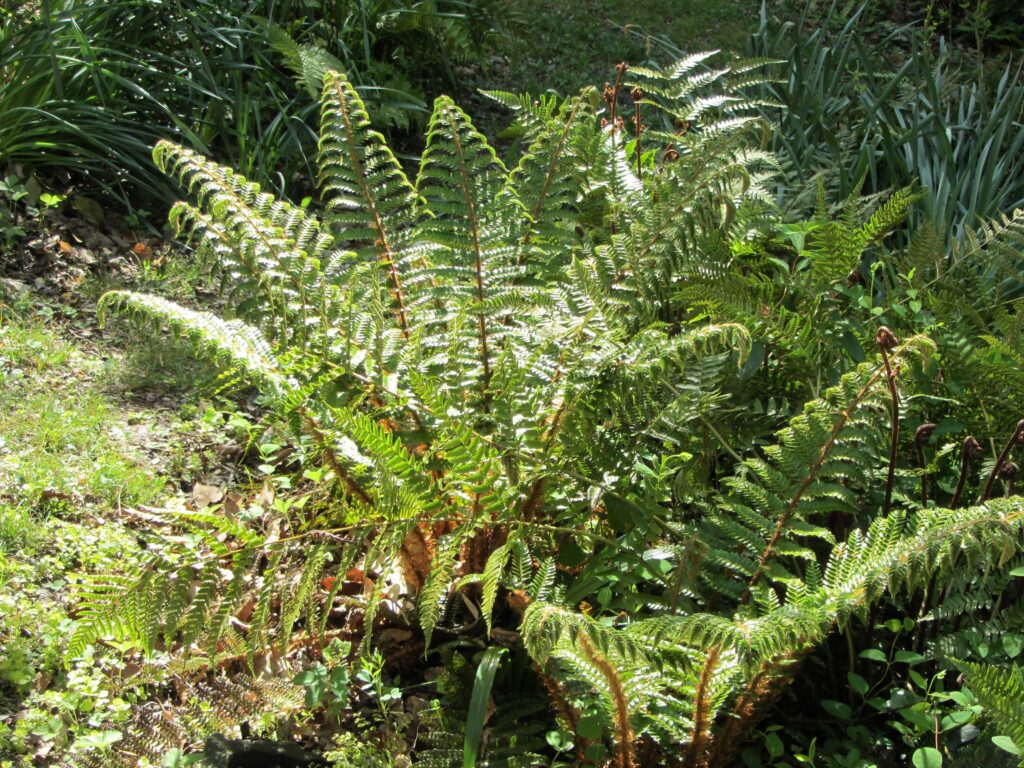
Polystichum polyblepharum, Korean tassel fern, grows to about 2′ high and wide. Wildlife don’t graze it, but birds will pick at the hairs on its stipes to use to line their nests. This is an evergreen fern, but its fronds usually lie flat on the ground by spring.
I lose count of how many new ferns I plant each season. So many ‘problem areas’ of our forested yard show great potential for transforming into fern gardens, that I keep collecting more species each year, and buy more fern babies of my favorite selections. And then there are the many sporelings I’ve learned to raise thanks to my membership in the Hardy Fern Foundation. These days, I always want to harvest ripe spores from a frond of any new variety, then shake them over a dish of sterilized soil to see what will grow. It may take a year of patient care for the sporelings to emerge, but they are entertaining, aren’t they? Shady spots on our deck serve as a nursery for those little sporelings growing on into their 4” pots before I plant them out.
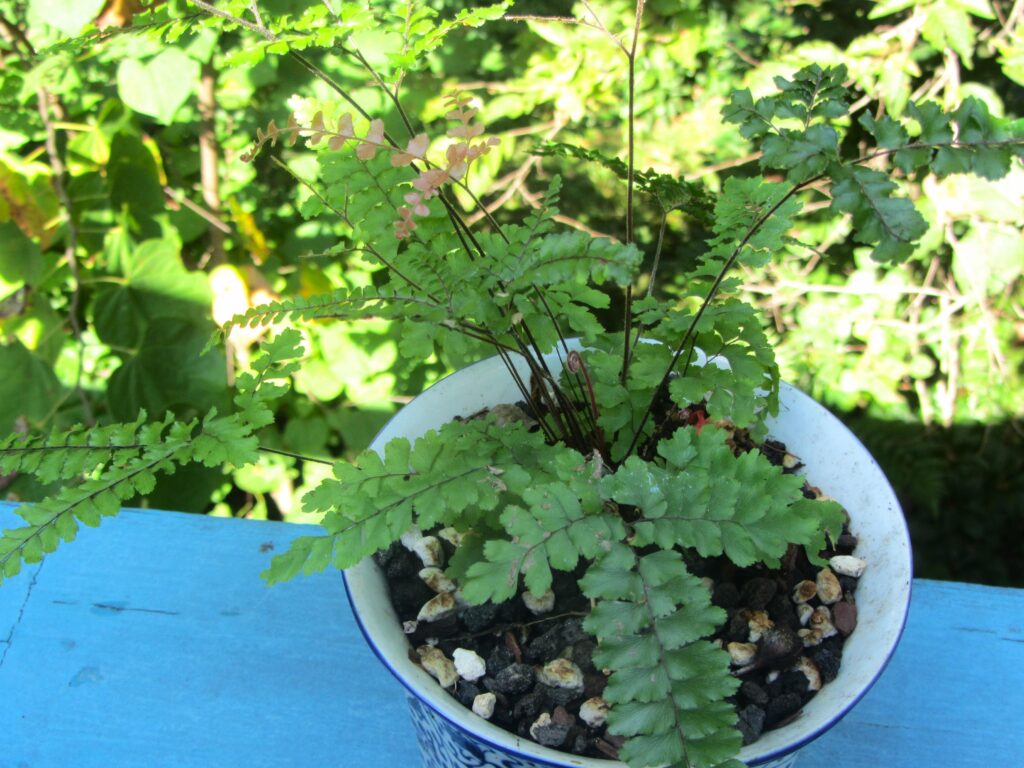
An Adiantum grown from collected spore grows a bit larger on the deck, before it is planted out into the garden.
My plans hummed along beautifully for a very long time as our fern gardens grew fuller and more interesting year upon year. The two D. ‘Autumn Brilliance’ I packed into the back of the car when we moved here are well over 4’ tall now, as round as shrubberies, and still growing strong. I offer advice about ferns, sought and unsought, to anyone who comes to me with a garden problem to solve that isn’t happening in full sun.
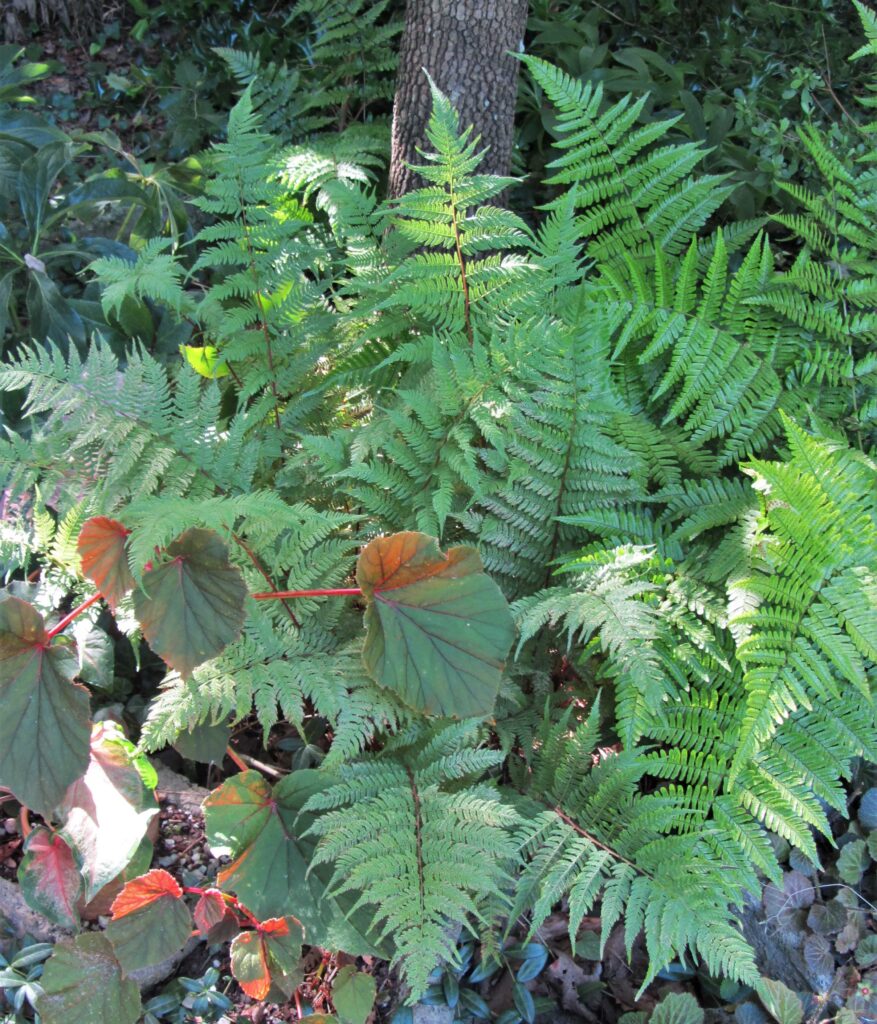
Athyrium filix-femina var. Angustum ‘Lady in Red’ has tall, lacy fronds and red stipes. It is a very dependable deciduous fern that grows here beneath a dogwood tree.
The Only Constant is Change
And then things changed. I can’t say exactly when I began to notice the difference; there is no note on my calendar. But I would notice a frond nibbled here and there from time to time. At first, it was just on those very delicate Athyriums, the Japanese painted ferns that I love so much. A. ‘Godzilla’ would sometimes go from stately to moss-like in a single night. Sometimes I’d find a newly planted A. ‘Ghost’ nearly entirely gone.
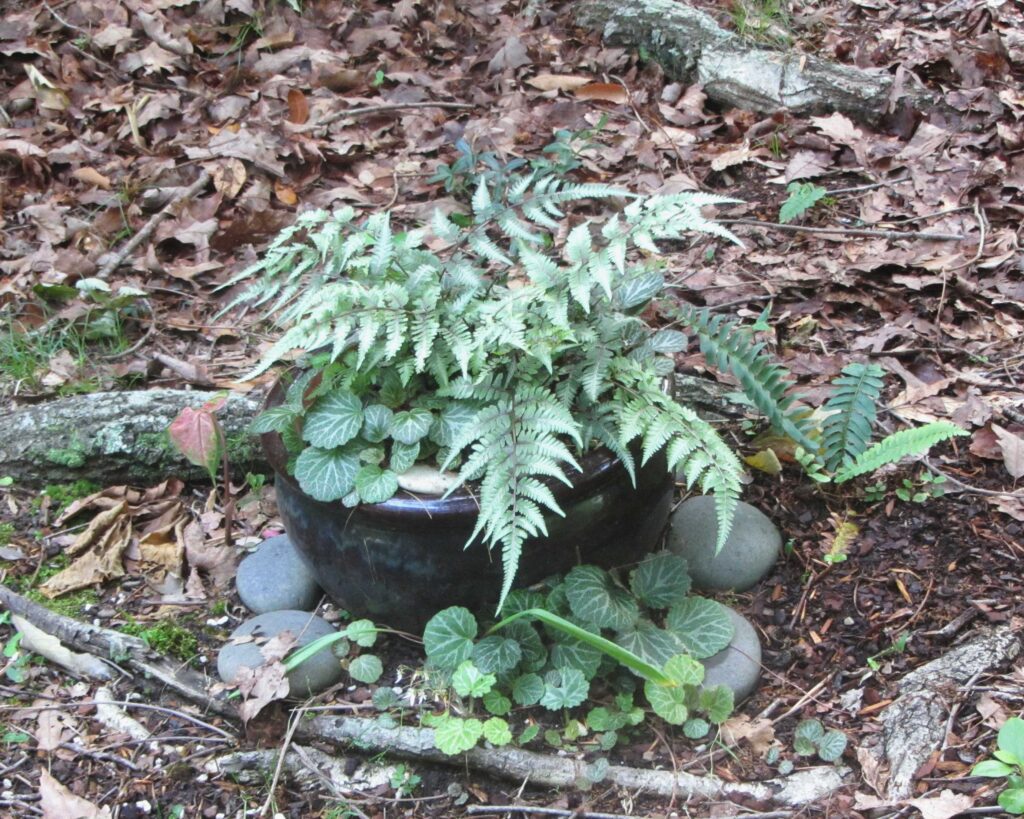
Athyrium niponicum ‘Godzilla’ is an exceptionally large Japanese painted fern that can grow to over 3′ tall and 6′ wide when planted in the ground. In a container, it still grows taller than most Japanese painted ferns when given the chance. This is its first flush of growth for the spring. A newly planted Christmas fern grows to its right, under a large oak tree.
Sometimes I’ll notice a newly introduced fern species particularly targeted for consumption. I was enchanted by articles about the beautiful introduction of D. wallichiana, ‘Jurassic Gold,’ and so bought a half dozen the first time they showed up in our local garden center. I tried planting them in several different areas of our fern gardens to learn where they would grow best. Not even one made it through until the following spring. They must have been tasty to someone, and clearly don’t like our conditions here. My only partial success has been with those planted in hanging baskets, out of reach.
Korean rock ferns, P. tsus-simense, have also failed to thrive in some areas. They produce itty-bitty skinny fronds that just begin to grow when they are nibbled away yet again. At least their roots live on, so my hope for their success endures. Before my experience with this species, I always considered Polystichums as one of those genera that grazers leave strictly alone. But no…
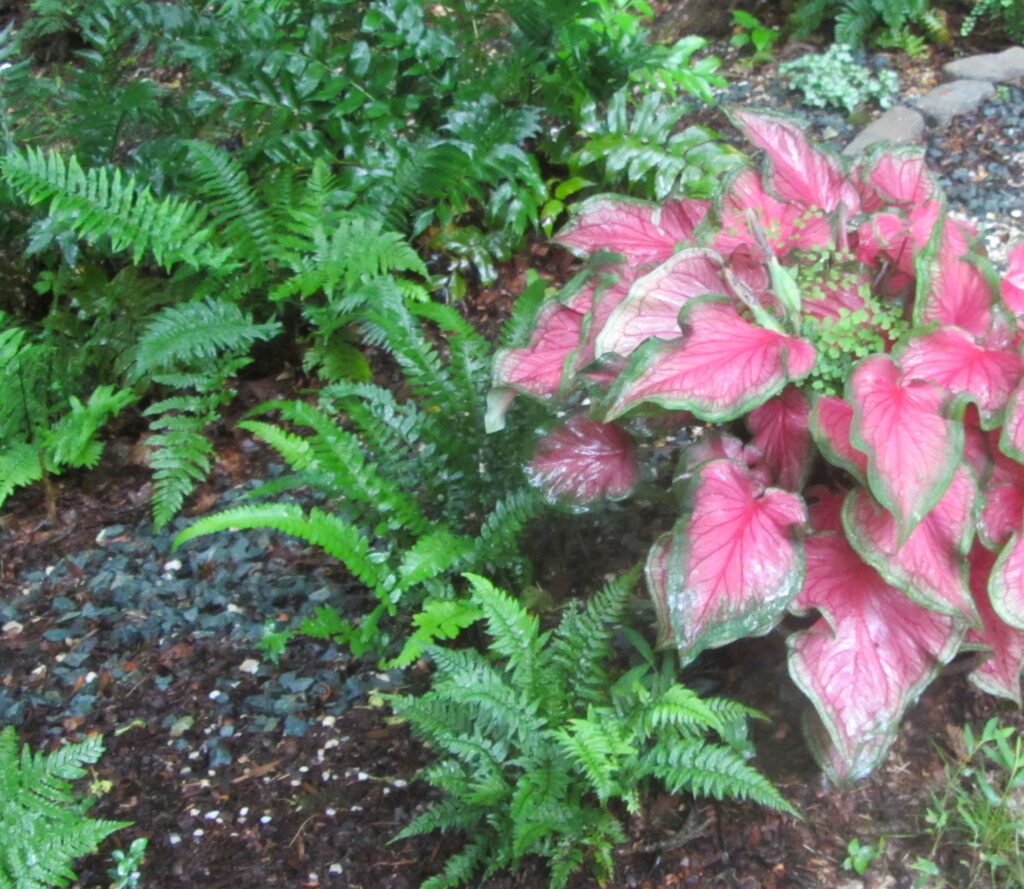
A Korean rock fern, Polystichum luctuosum, grows to the left of the Caladiums, with Deparia lobato-crenata, Japanese sword fern, just behind in the center of the photo. The Deparia continue to expand as a ground cover fern and may cover 6′-7′ feet of garden space ten years after planting. Adiantum peeks out from the Caladium planting.
This past spring, I was horrified to discover severed fiddle heads littering the ground around a great many ferns, including some Christmas ferns and holly ferns. What would do that? Why sever the fiddleheads and not eat them? The ferns were resilient, and more fronds followed, so that today the ferns look lush as summer melts into fall.
We have had so many dry spells this summer that I believe that the animals that frequent our yard are eating most anything that offers a bit of moisture, including ferns. Plugs of sporeling sized Christmas ferns that I planted last fall and again in the spring would disappear within a few days. A few recovered, but not all. It appears that even the box turtles in our yard have taken to grazing on small and tender fronds. A few disappeared, roots and all, into a subterranean rodent tunnel.
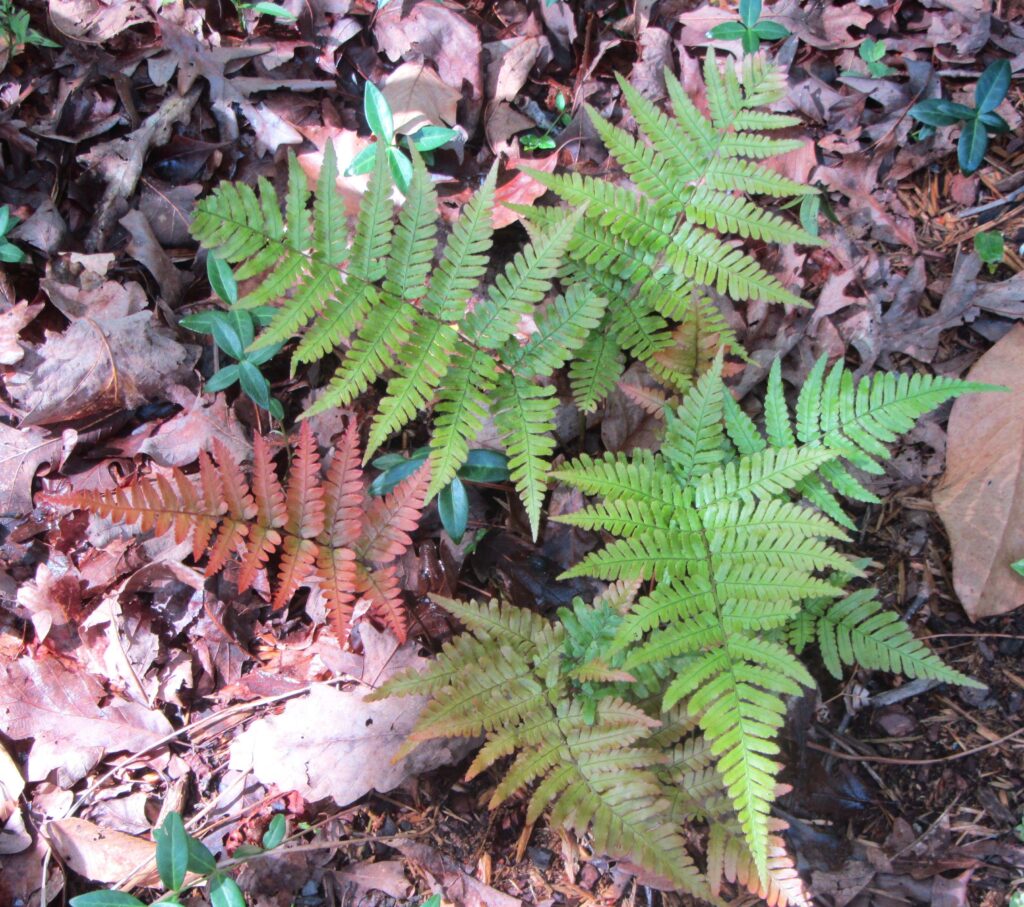
A young Dryopteris erythrosora ‘Autumn Brilliance’ emerges in late spring. Planted in 2023, it had only a frond or two through the winter. Newly planted ferns may take several years to establish and achieve their potential for size and vigor.
I also see evidence of voles, or perhaps even mice, severing fronds of ‘Autumn Brilliance’ and leaving them to flop in place. When I pick up the fronds, the little gnaw marks of their tiny teeth at the base of the severed stipe tell the tale. We are fortunate that not all our ‘Autumn Brilliance’ ferns were targeted; just a few here and there.
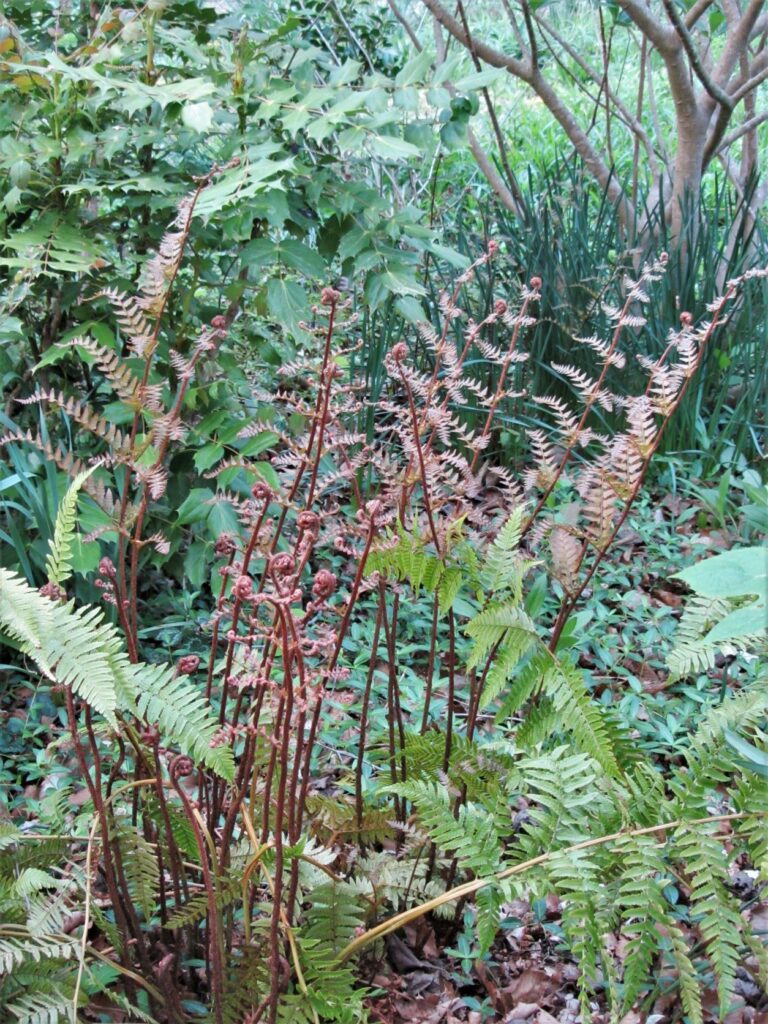
Dryopteris erythrosora ‘Brilliance’ remains evergreen through the winter. New fronds emerge in shades of copper throughout the season. While deer and rabbits used to ignore it, this plant sustained some damage over winter 2024.
Nurturing and Protecting the Ferns
So, caring for the ferns has required some extra effort in recent years. Not only to keep them watered through our hot, dry spring and summer, but also to protect them as much as we can from the resident wildlife. Since earliest spring when those first severed fiddleheads appeared, I have been applying both granular and spray animal repellents every few weeks wherever I have noticed damaged ferns. I use both Plantskydd and Repels-all. Both brands produce a shakable granular product as well as a spray on product. I switch them out so neither one becomes too familiar. But neither is 100% effective, either.
While that may sound a bit like ‘over-kill’ to use both forms of animal repellent, I expect that the granular formula, which lasts longer than the spray, will also help to discourage voles from surfacing to attack fronds at ground level. The sprays make the fronds less palatable should a Bambi or bunny try to eat them. Milorganite is another very effective granular repellent which is sold as an organic fertilizer. One broadcasts this product in broad bands to protect valuable plantings. Like the others, it smells unpleasant when first spread, and the odor lingers at a level that keeps most animals away for up to three months.
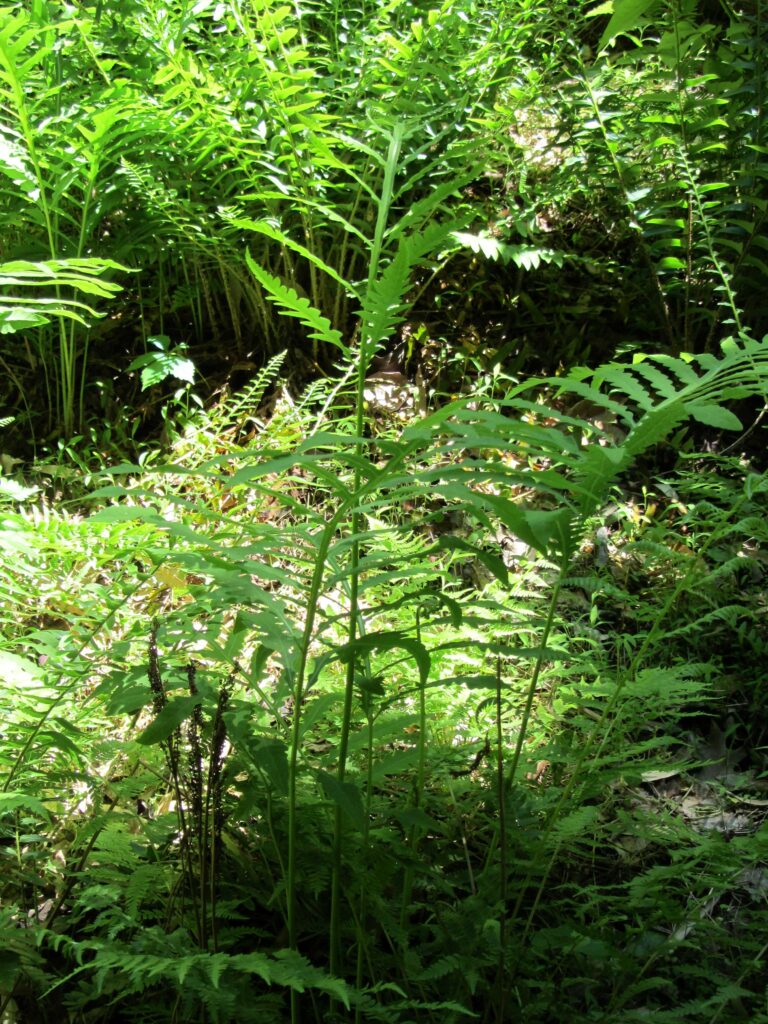
Onoclea sensibilis, sensitive fern, spread on runners and rarely requires any care once they are established. I’ve not seen animals grazing these ferns at all. They need watering only occasionally, when there is an extended drought. Their fertile fronds stand through the winter. They are emerging here in mid-spring.
… And Nurturing the Wildlife
But I’m also more mindful of the needs of our wildlife and maintain a low bowl of clean water on the patio to support many types of animals who visit it each day and night. My hope is that when they are less thirsty, they will be less likely to attack our ferns and flowering plants. Watering the fern gardens frequently also helps support those small animals living among them. We had baby fawns resting in a patch of ‘Autumn Brilliance’ through much of the summer, but at least they didn’t try to eat them.
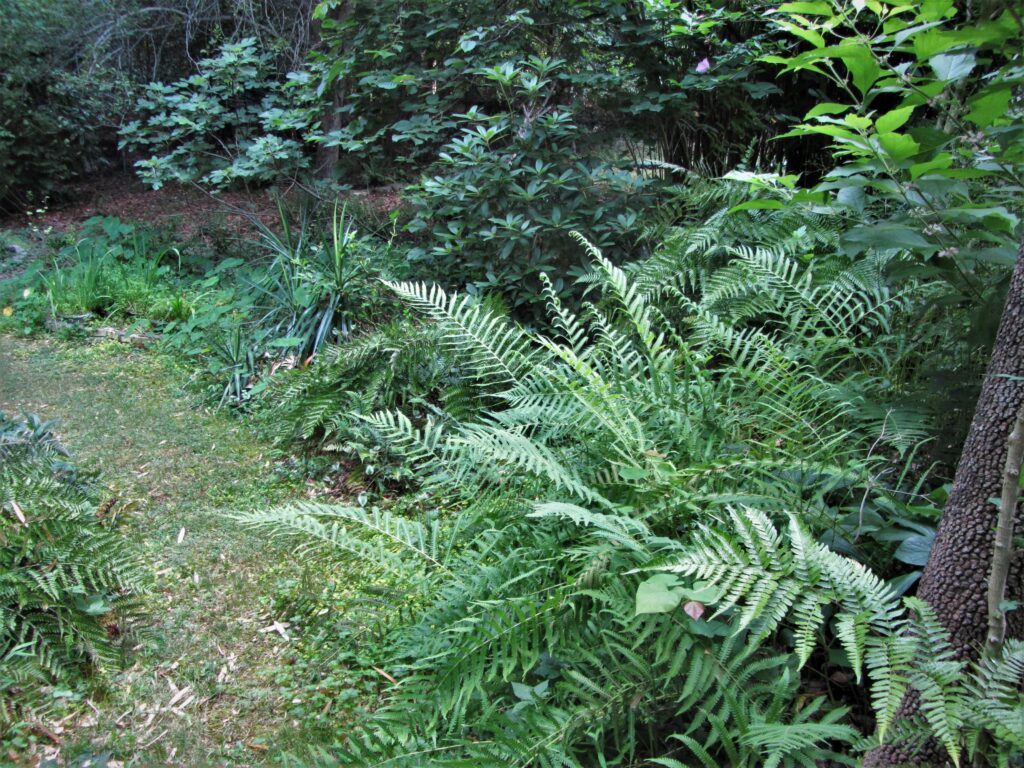
Thelypteris palustris var. pubescens, Eastern marsh ferns, on the right side of the path, will thrive in bright sunlight to partial shade so long as they grow in moist soil. These tall, impressive ferns, easily mistaken for Southern lady ferns, spread a bit more each year.
Adapting to a Changing Climate
In case you are wondering, I still enthusiastically recommend ferns to anyone who will listen. I just no longer offer ferns up as a nearly bullet-proof solution for every shady garden. I offer a more nuanced recommendation. I suggest that they protect young ferns from grazing wildlife, even though many ferns are considered ‘deer-proof.’ I also suggest they make their ferns more drought tolerant by mulching well with gravel, wood chips, or pine tags. A product like Perma-till, or even pea gravel mixed in around a new planting hole helps repel voles for those first few years.
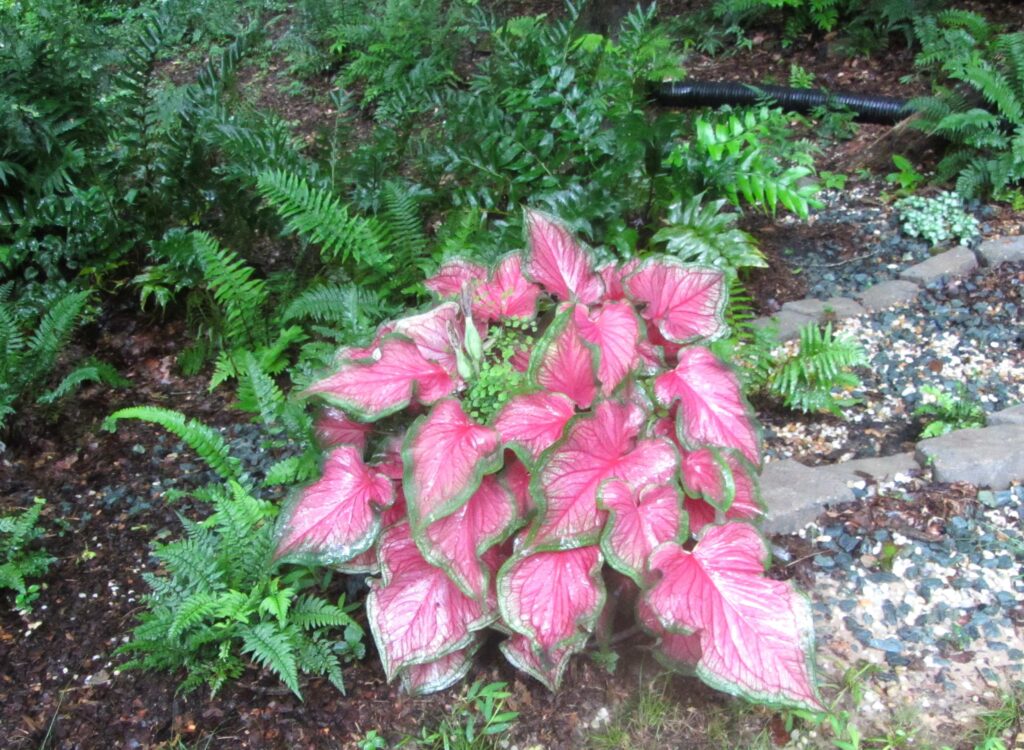
This hillside fern garden remains ‘under construction,’ with new ferns added over the past four to five years. The holly ferns behind the Caladiums were among the first ferns planted and are reaching their mature proportions.
As our climate becomes more unpredictable, I also like to plant thirsty ferns near a wall, a concrete block, a stump, or a large planter that helps to hold moisture in the soil close to their roots. I particularly like to plant mosses as ground cover around ferns and try to reduce competition by keeping fern beds well-weeded, especially from any encroaching grasses.
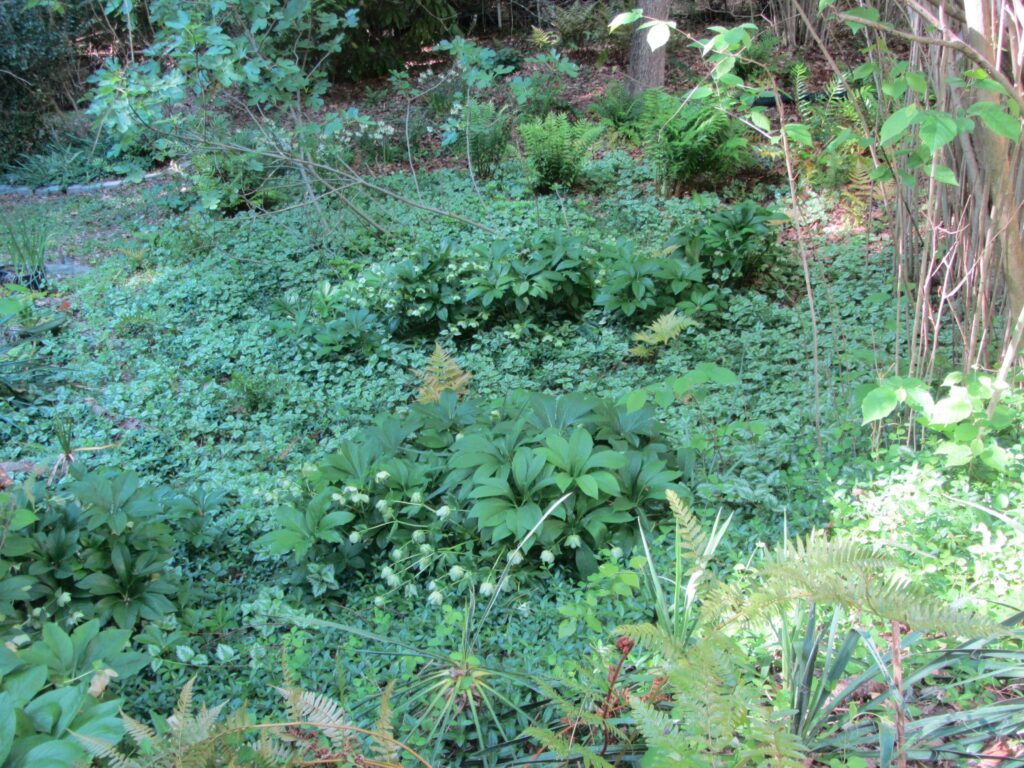
Newly planted Dryopteris dot this very shady space dubbed, ‘fern grotto.’ This area is planted with a mix of native and Asian fern species.
Ferns are not only beautiful and useful, but they also prove incredibly resilient. I could barely contain my joy when a baby Christmas fern planted and thought lost in 2023 reappeared this spring. The roots survived, though the fronds were gone by fall, and it has grown well all summer long. When we can nurture young ferns through the first few years or growth, until they can get established, they generally survive whatever nature inflicts. Those of us who love our ferns will go to great lengths to give them a good start in our gardens. Regular attention and care ensure they will remain our faithful garden companions for many more years to come.
Here is a baker’s dozen of favorite hardy ferns for coastal Virginia, Zone 8a:
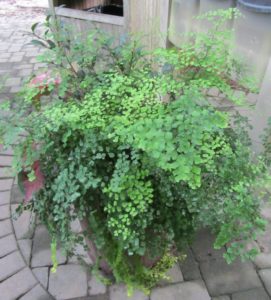
Deciduous ferns, like this Southern maidenhair fern, Adiantum capillus-veneris, will die back to the soil after frost and remain dormant until early spring.
Adiantum capillus-veneris
Athyrium niponicum
Cyrtomium falcatum
Cyrtomium fortunei
Deparia lobato-crenata
Dryopteris x australis
Dryopteris erythrosora ‘Autumn Brilliance’
Dryopteris ludoviciana
Onoclea sensibilis
Polystichum acrostichoides
Polystichum polyblepharum
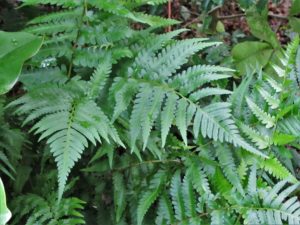
Dryopteris x australis is a natural hybrid of two native wood ferns. It grows to 5′ tall and remains green late into winter.
Polystichum setiferum
Thelypteris palustris var. pubescens
This article was also published in The Hardy Fern Foundation Quarterly Winter 2025
All photos by E. L. McCoy

